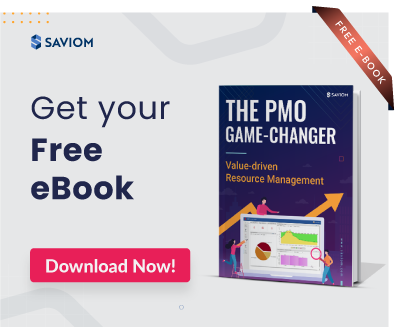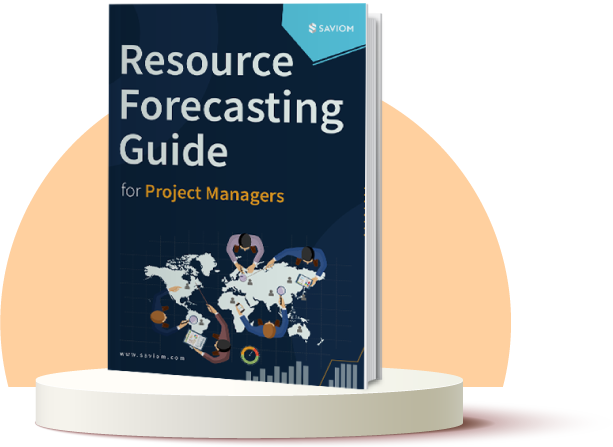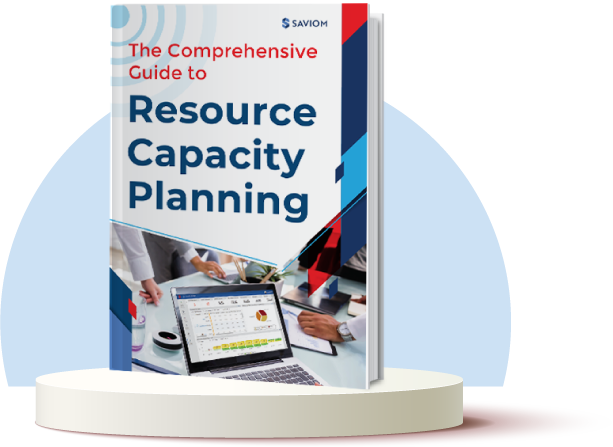Over the years, the concept of PMO has been gaining popularity across multiple industries and types of organizations. Initially, it was only familiar to large, multinational firms, but later, numerous small and medium-sized companies started adopting a PMO for efficient project management and to achieve their strategic goals.
In fact, according to Statista, 80% of organizations have one or more PMOs.”
The Project Management Office (PMO) serves as a central hub for project oversight, governance, and support, ensuring that projects are executed effectively and aligned with business objectives.
But what exactly are the roles and responsibilities of a PMO within an organization? Understanding the roles and responsibilities of a PMO is crucial for organizations looking to enhance project delivery, increase efficiency, and achieve business objectives.
This blog will provide valuable insights into the significance of a value-centric PMO, their primary roles and responsibilities, and how they contribute to successful project outcomes.
But first, let’s begin with the PMO definition.
What does PMO (Project Management Office) mean?
A project management office (PMO) refers to a group, department, or entity within the organization responsible for providing management reports, establishing guidelines, and a governance framework.
The primary role of a PMO is to establish and maintain project management standards, processes, and best practices, ensuring that projects are executed efficiently. Further, they also enable optimal utilization of resources, help a business achieve strategic objectives, and protect it against market volatility.
Now that you are clear about what is the pmo, let’s understand the roles and responsibilities of Project Management Office.
What are the PMO roles and responsibilities?
A value centric PMO can play a wide range of roles in modern business. It can potentially be a game-changer for a project-based company.
Some of the responsibilities of a project management office include:
Establish project governance structure
PMO establishes a project governance framework with a structured approach to govern the projects. It involves various stakeholders like team members, project managers, project sponsors, investors, clients, etc. These stakeholders have well-defined roles, responsibilities, and decision-making capacities. The purpose of the governance structure is to ensure that:
- The projects are prioritized and aligned with the short- and long-term goals of the business
- The right people have access to the right information to make the right decisions
- The projects are staying within the planned time and budget
- Enterprise resources are utilized in the most efficient manner
- There are ongoing risk assessments and mitigation across all projects
Provide management reports
One of the core PMO roles and responsibilities is to centralize information and deliver it to the right stakeholders. It is to ensure that the management makes informed and timely decisions for the success of the project. Following are some examples of management reporting:
- Overall progress and health of projects
- Status of milestones and deliverables across the portfolio
- Financial information about the budget, forecast, actuals, margins, etc.
- Project risks and progress on mitigating these risks
- Operational efficiency and project performance
- Effective management and utilization of enterprise resources
Read More: 5 Essential Project Reports That Every Project Manager Must Look Into
Prioritise projects as per strategic business objectives
Setting up operational and strategic objectives is critical to future business planning. They are essential to short- and long-term business success. These objectives are achieved with the help of various programs and portfolios consisting of projects. PMO plays a crucial role in this process and carries the following responsibilities:
- Ensure that the programs and portfolios are aligned with operational and strategic objectives
- Projects are selected and prioritized as per these business goals
- Enterprise resources are allocated and utilized as per business goals
- Design and track various program and portfolio performance KPIs
Plan and schedule resource efficiently
Resource planning is one of the most critical duties of the project management office (PMO). This process ensures that the right resources are allocated to the right project at the right time. These are some highlights of efficient resource planning and scheduling:
- Eliminate silos of spreadsheets with a single resource plan
- Create visibility of resource capacity, competency, and availability for all stakeholders
- Establish a real-time resource scheduling to accommodate the fast-changing ground reality
- Track all types of work, i.e., project work, non-project work, vacation, etc.
- Establish multi-dimensional viewing and overcome the challenges of a matrix structure.
Forecast and enable resource capacity planning
In a dynamically changing business environment, it is critical for a PMO to forecast and get real-time foresight into project resourcing. So that the PMO can take corrective actions ahead of time.
A few examples of resource forecasting are:
- Forecast capacity vs. demand to identify shortfall or excesses of the resources
- Forecast people on the bench and project vacancies to minimize resource wastage
- Forecast resource management financials to determine the margin and profitability.
Read More: What is Resource Capacity Planning? An Ultimate Guide for Every Project Manager
Streamline and automate processes and workflows
As an integral part of performance improvement, PMO streamlines various project management processes and methodologies. For examples:
A few examples of resource forecasting are:
- Establish project requesting, selection, and prioritization process
- Streamline workflow for resource requisition and allocation
- Gathering up-to-date information about employee skills, interests, experience
- Forecast and provide early warning before it is late
Reuse project learning and knowledge
The Project Management Office enables team efficiency by facilitating knowledge transfers between departmental project teams. It makes project plans, reviews, templates, and documentation widely available to concerned members.
This helps them to save time and costs that would have otherwise gone into rework. Rather than reinventing the wheel, project teams can not only shorten their learning curve but can also get more work off the ground from the organizational knowledge being shared.
Mentor and train project managers
The PMO support includes providing mentoring and coaching to the project managers. After all, they are at the heart of the project lifecycle.
Developing a project manager’s competencies enhances their ability to lead and manage project execution and team dynamics.
Moreover, it equips them to gauge their team’s strengths and prevent member conflicts. This way, projects can tap into potential from within, with staff whose critical skills and knowledge can be used to complete tasks and help one another.
Maximize strategic & billable resource utilization
Employees must work on a billable or strategic project for a project-based company. So, the PMO team must work on maximizing its workforce’s billable and strategic utilization. To achieve this, a PMO constantly forecasts the utilization of resources and moves them to billable and strategic projects.
Read More: Maximize Profitable Resource Utilization with Modern Resource Management Solution
Facilitate team collaboration and communication
It is now a critical responsibility of a PMO to ensure that there is an efficient framework for seamless team collaboration and communication among team members. It helps in
- Aligning remote teams and bringing everyone on the same page
- Completing task faster without unnecessary waiting
- Communicating faster with the right person without chaos
- Addressing urgent issues faster and more effectively
McKinsey & Company states that employee productivity increases by 20-25% when employees are connected.
Now that we understand the Project Management Office roles and responsibilities, let’s learn about the various types of PMOs.
What are the types of PMO?
Modern PMO is divided into different types based on organizational structure and function.
The typical Project Management Office structure is as follows:
Project management office:
A Project Management Office is focused on supporting project managers and their teams in successfully delivering individual projects. It provides guidance, best practices, templates, and tools to ensure consistency and efficiency in project management practices.
Program management office:
A Program Management Office is responsible for overseeing a group of related projects that are aligned with a specific program or objective. It focuses on managing interdependencies among projects, resolving conflicts, and ensuring that projects achieve organizational goals without setbacks.
Portfolio management office:
The Portfolio Management Office oversees the entire portfolio of collective projects and programs across the organization. It manages the allocation of resources, prioritizes projects based on strategic objectives, and monitors performance across the various programs.
Enterprise-level PMO:
An enterprise-level PMO is responsible for aligning project management tasks with the organization’s overall strategy and goals. It oversees all program and project management responsibilities across the organization and ensures that projects and programs align with its overall strategy.
In terms of function, PMO can be classified into three main types.
Supportive PMO:
Such type of PMO supports and guides project managers as and when required. It focuses on creating a framework of processes, governance, training modules, and mentoring programs that help project managers in daily operations. Usually, a supportive PMO functions as a consultative entity.
Controlling PMO:
A controlling PMO focuses on enforcing project management processes and standards across the organization. It reviews and approves project plans, monitors project progress, and identifies potential risks and issues. The controlling PMO also ensures that projects align with the organizational objectives.
Directive PMO:
This type of PMO positions itself as a decision-making authority with a higher degree of control or complete control to direct projects. A directive PMO operations includes assigning project managers, providing resources and support to managers, and controlling the project budget and schedule.
Since we now know about the PMO structure and roles & responsibilities of each type, let’s dive into the business benefits of a PMO.
What are the benefits of a Project Management Office (PMO)?
PMO helps organizations deliver projects successfully within time and budget. Here’s how-
Enables real-time visibility across the enterprise
PMO replaces silos of spreadsheets with a centralized system. It enables the PMO department to collect data directly from the originating sources and makes them visible to different stakeholders as per their specific roles. This real-time visibility fosters collaboration and informed decision-making.
It further streamlines communication, enhances project tracking, and empowers executives, project managers, and team members with up-to-date insights, ultimately driving greater efficiency across the entire organization
Implements standards and best industry practices
Traditionally, a PMO defines project management standards and guidelines as well as sets up a project governance structure. In addition, it evaluates and identifies best practices in its specific industry and implements them in the business.
This proactive approach not only ensures consistent project execution but also enhances overall quality, reducing project risks and deviations. Furthermore, by aligning with industry best practices, the PMO keeps the organization well-prepared for evolving market trends and customer demands, ultimately fostering long-term success and growth.
Read More: Resource Management: A Comprehensive Handbook for Project Managers
Aligns projects with business objectives
A value driven PMO helps the management in selecting and prioritizing the projects aligned with their strategic and tactical business objectives. In addition, it can track and improve the strategic utilization of resources. Furthermore, a value-driven PMO fosters adaptability by regularly assessing project performance against established objectives and adjusting strategies as needed.
By promoting a clear link between project investments and business outcomes, it enhances accountability, transparency, and the overall strategic agility of the organization, ensuring a sustained competitive advantage in an ever-evolving marketplace.
Helps in business decision making
A PMO’s job includes tracking major KPIs and forecasting metrics related to the projects, programs, portfolios, resources, risks, etc. They generate reports for different levels of management to help them make timely decisions.
These reports serve as critical tools for executives and stakeholders to assess project health, allocate resources judiciously, and align projects with strategic goals. The PMO’s data-driven approach not only aids in identifying trends and potential issues but also facilitates proactive decision-making, eliminating potential bottlenecks.
Helps in reducing project resourcing cost
A value-driven PMO does forward planning and allocates the right resources for the right projects at the right time. This approach minimizes the need for last-minute, expensive recruitment.
As a result, it helps reduce resourcing costs significantly. Further, as the right resources are available during the project initiation, it helps in timely completion of the project. Hence, increasing profitability for the organizations and improving customer satisfaction.
Improves effective resource utilization
Organizations can improve their profitability and sustainability with a PMO. It helps track future resource demand and forecasts billable, non-billable, and strategic utilization. Hence, PMOs can proactively mobilize resources from non-billable to billable and strategic work.
Further, PMOs can check whether a resource is over/underutilized and take course corrective measures to ensure optimal utilization. This ensures that the right talent is available when and where it’s needed, maximizing productivity and preventing employee burnout.
Read More: How to Measure Different Types of Resource Utilization
Optimizes project workforce to beat market volatility
A value-driven PMO does capacity planning to forecast shortages or excesses of resources due to market volatility. It helps build an optimized workforce without extra overhead so that the business is not affected due to market volatility or business uncertainties.
Furthermore, PMOs can create the right mix of contingent and permanent employees to meet future project demand. This helps PMOs not only reduce costs but also improve scalability, enabling the business to seize opportunities and mitigate risks effectively in the fast-changing market conditions.
Shares project knowledge
There is always plenty of learnings, lessons, skills, and experience acquired while executing a project. A value-driven PMO collects this knowledge intelligently and shares them with other projects.
By facilitating the access to collective wisdom from previous projects, it empowers managers to draw inspiration and guidance for upcoming projects, significantly improving the likelihood of success. This knowledge-driven approach enhances decision-making, minimizes risks, and fosters a culture of continual improvement, ultimately leading to better project outcomes
Improves communication and productivity
Complexities of project execution have multiplied many folds due to matrix organization structure and remote working. So, PMO operations have started providing a collaborative framework for these teams to improve communication and avoid chaos.
This collaborative framework fosters cross-functional teamwork, breaking down silos and enhancing synergy among diverse teams. By facilitating streamlined communication and providing standardized processes, the PMO boosts productivity, minimizes project delays, and ensures that project objectives are met efficiently, even in the face of complex organizational structures and remote work challenges.
Read More: Top 10 Business Benefits of a Value Centric PMO
Knowing the benefits of a PMO, let’s see how an organization can set up a successful PMO.
How to establish a successful PMO in your organization?
Establishing a successful Project Management Office in an organization involves careful planning, clear objectives, and effective execution. Here’s a step-by-step guide to help you establish a successful PMO:
Assess the current state of project management
Before establishing a successful Project Management Office (PMO), it’s crucial to assess the organization’s existing project management practices. For this, firms can first conduct a thorough analysis of ongoing projects, identifying the strengths, weaknesses, and gaps in project management practices.
Further, firms can also gather feedback from project teams and stakeholders to gain insights into the pain points and areas needing improvement. This assessment will provide a baseline for understanding the organization’s current project management state, ultimately helping you tailor the PMO’s objectives and strategies.
Determine the specific purpose of your PMO
The next step is to clearly define the purpose and objectives of your PMO. This purpose should align with your organization’s strategic objectives. Whether it’s enhancing project delivery, resource allocation, risk management, or portfolio management, articulating a specific mission helps set the direction and expectations for the PMO.
For example- If the goal is to enhance project delivery, the PMO can streamline processes and provide best practices. In the case of resource allocation, it can optimize resource utilization. For risk and portfolio management, the PMO can establish frameworks to minimize risks and maximize returns. This alignment ensures that the PMO’s efforts directly contribute to the organization’s success.
Recruit the right project management professionals
The success of your PMO hinges on having the right talent in place. Hence, it’s essential to identify and recruit project management professionals with necessary skills. Depending on the size and complexity of the PMO, various roles may be required, such as project administrators, technical specialists, training professionals, and project managers with diverse expertise.
Furthermore, the recruitment process should be meticulously tailored to align with the PMO’s strategic objectives. Collaborating closely with senior leaders and stakeholders ensures that the selected professionals not only possess the requisite skills but also resonate with the organization’s culture and vision. This approach fosters a dynamic and well-rounded team capable of navigating the multifaceted challenges of project management, ultimately increasing the PMO’s ability to deliver successful outcomes.
Craft a detailed Project Management Office charter
After that the next step is to prepare a PMO charter that will serve as the guiding document for your PMO. It outlines the PMO’s objectives, scope, responsibilities, governance structure, and key stakeholders. Additionally, the PMO charter should define decision-making processes, roles, and escalation procedures, ensuring clarity in project governance. It should also establish performance measurement criteria to assess the PMO’s effectiveness over time.
Once the charter is created, firms should share the charter with relevant parties, ensuring alignment and understanding of the PMO’s role within the organization. Further, regular updates and reviews of the charter is needed as it will help keep the PMO aligned with the organization’s evolving needs and goals.
Choose appropriate PMO model for your firm
Selecting the right Project Management Office (PMO) model is a pivotal decision that can greatly impact an organization’s project management effectiveness. The choice should be informed by factors such as the organization’s size, industry, and strategic objectives. For example- in smaller, innovation-driven firms, a supportive PMO model is often preferred. It offers guidance, best practices, and expertise, nurturing project management maturity while allowing flexibility for creative endeavors.
In contrast, larger organizations may lean towards a controlling PMO model, emphasizing standardization, compliance, and risk management. However, regardless of the chosen model, it’s essential for firms to remain flexible and open to adaptation, allowing the PMO to continually align with shifting needs and goals, ultimately enhancing project success rates and overall organizational performance.
Develop standardized project management processes
Standardized project management processes are the cornerstone of an effective Project Management Office (PMO). These processes provide a consistent framework for initiating, planning, executing, monitoring, and closing projects across the organization. In the initial phase, it’s crucial to comprehensively identify and document these processes.
This includes defining project roles, responsibilities, workflows, and specifying the tools and templates to be used. In the second phase, the focus shifts to implementation and integration of these processes. For this, firms can establish thorough training and educational initiatives. These programs are designed to ensure that all team members possess a clear understanding and the ability to effectively apply standardized processes.
Establish a plan for Key Performance Indicators (KPIs)
Key Performance Indicators (KPIs) helps Project Management Office (PMO) towards success. The initial step involves defining KPIs that align precisely with the PMO’s objectives and the broader organizational goals. These KPIs should be specific, measurable, attainable, relevant, and time-bound (SMART) to provide meaningful insights into performance.
Once established, it is crucial to regularly track and assess the selected KPIs to gauge the PMO’s effectiveness. This ongoing evaluation allows for timely identification of bottlenecks, inefficiencies, or areas requiring improvement. Further, the insights gained from these KPIs also facilitate informed decision-making and help the PMO adapt strategies to align with evolving organizational needs.
Next, let’s learn about the essential elements to look for in a modern PMO software.
What to look for in value-driven PMO software?
As discussed in the previous section, a value-driven PMO carries many responsibilities for modern business. So, it is critical to have a tool with all required functionalities to help deliver PMO tasks and responsibilities.
Project Management: A PMO software requires functionalities to manage a project efficiently. It should have capabilities for project scheduling with WBS, milestone tracking, risk management, document tracking, etc.
Portfolio Management: It is critical to have a bird’s eye view of various projects run in the business. PMO software requires portfolio management functionalities to help track various project KPIs and provide early warnings about the projects.
Resource Planning & Allocation: A PMO tool requires a centralized resource planning facility. It ensures that the right resources can be identified easily in a large pool of resources. It helps to allocate the right projects at the right time.
Read More: What is Resource Scheduling? How to Schedule Resources for Projects Efficiently?
Resource Capacity Planning: This is one of the most critical functionalities of PMO software. It would help a business forecast shortfalls or excesses of resources so that the right resource treatment can be applied to the resource pool to have an optimized workforce.
Work Management: In a matrix organization structure, it is complex to track work allocated to an individual from multiple projects across the globe. Work can be related to a project or non-project activity. So, the PMO tool must have a full-fledged detailed work allocation and tracking facility.
Team Collaboration: Team collaboration is part and parcel of seamless communication for distributed teams and members working from home. So, PMO software has to have a team collaboration facility to improve productivity and responsiveness.
Next, we dive into the future trends of the PMO.
What does the future of PMO look like?
The future PMO (Project Management Office) is expected to undergo significant changes to meet the evolving demands of project management in a rapidly changing business landscape.
Let’s look at the future trends for PMOs:
Adoption of agile project management methodologies
The PMO of the future will embrace agile methodologies and adaptive project management approaches to enhance project delivery. Agile frameworks such as Scrum or Kanban will replace or supplement traditional waterfall methods. In addition, PMOs will prioritize iterative development, collaboration, and flexibility to respond to changing requirements and market conditions.
To support this shift, PMOs will foster a culture of agility and provide training and resources to project teams. They will also leverage agile project management tools and techniques to facilitate effective communication, collaboration, and transparency among team members.
Strategic alignment between project management and business objectives
PMOs will evolve into strategic partners, critical in aligning project portfolios with organizational objectives. They will collaborate closely with top management to prioritize projects, allocate resources, and ensure that projects contribute to the organization’s strategic goals.
PMOs will develop robust portfolio management frameworks, provide comprehensive project performance reporting, and facilitate informed decision-making at all levels of the organization. They will also proactively identify and manage risks and dependencies across the project portfolio to minimize potential disruptions.
Embracing digital transformation and automation
Future PMOs will leverage advanced technologies and automation to streamline project management processes. Everything will be automated using project management software, from project documentation to reporting and administrative tasks, enabling PMO staff to focus on value-added activities. These sophisticated tools integrated with Artificial intelligence (AI) and machine learning (ML) will help PMOs to analyze data, identify patterns, and gain predictive insights for decision-making.
Furthermore, PMOs will explore emerging technologies like blockchain and the Internet of Things (IoT) to enhance project transparency, security, and efficiency. Additionally, by embracing digital transformation, PMOs can facilitate remote project management, enabling virtual teams to collaborate effectively across geographies and time zones. Cloud-based project management platforms, video conferencing tools, and virtual workspaces will become essential components of the PMO’s toolkit.
Emphasis on innovation and continuous improvement
PMOs of the future will foster a culture of innovation and continuous improvement within project teams. They will encourage experimentation, creative thinking, and knowledge sharing to drive innovation in project delivery. PMOs will establish mechanisms such as innovation labs, cross-functional collaboration platforms, and idea management systems to capture and implement these innovative ideas.
To support continuous improvement, PMOs will emphasize lessons learned and best practices. They will facilitate post-project reviews, conduct project audits, and promote knowledge-sharing sessions to capture insights and enhance project performance over time. The PMO will act as a catalyst for organizational learning and continuous enhancements.
Data-driven decision making
PMOs will be driven by data analytics and business intelligence. They will leverage real-time project data to monitor performance, identify trends, and make informed decisions. Advanced analytics and visualization tools will provide stakeholders with actionable insights, enabling them to proactively address issues, allocate resources effectively, and optimize project outcomes.
PMOs will invest in data management capabilities to ensure project data’s accuracy, reliability, and security. They will also develop data-driven performance metrics beyond traditional measures, incorporating factors such as customer satisfaction, stakeholder engagement, and strategic business value.
In summary, the PMO of the future will be agile, digitally enabled, strategically aligned, and data-driven. It will drive innovation, facilitate collaboration, and continuously improve project delivery, ultimately contributing to the organization’s success in a rapidly evolving business environment.
Conclusion
The Project Management Office (PMO) drives project success and organizational efficiency. It encompasses various roles and responsibilities that contribute to effective project management and strategic alignment within an organization. Furthermore, the PMO catalyzes continuous improvement. As a result, PMO is an indispensable function that enables organizations to navigate the complexities of today’s business environment and drive overall excellence.
The Glossary
Read More: Glossary of Resource Workforce Planning, Scheduling and Management
The SAVIOM Solution
SAVIOM provides futuristic software to transform your PMO into a profit center. With over 20 years of experience working with highly valued global companies, this Australia-based MNC has helped more than 100 clients across 50+ countries address their specific business challenges. SAVIOM also provides tools for enterprise resource management, professional service automation, and workforce planning software. So, SAVIOM can help your business establish an efficient system geared toward your business challenges.












